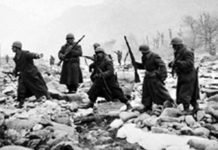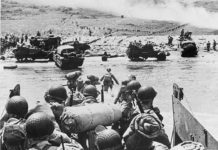The key to the Romans’ successes on the battlefield were their employment of deadly weapons, effective military formations, battlefield tactics, and their discipline during the heat of battle. Although the average Roman soldier was only 1.63 meters tall (5 feet 4 inches), they conquered many barbarian tribes with large and physically powerful men because of their organization, team work, and discipline.
Roman Infantry Weapons
The pilum and the gladius were two infantry weapons that gave the legion its famous flexibility and force; the pilum was a 2-meter long javelin used for both throwing and thrusting; and the gladius was a 50-centimeter long cut-and-thrust sword with a broad, heavy blade. For protection every Roman soldier was equipped with body armor that was either chain mail or plate armor and a metal helmet, and a rectangular or oval shaped shield. In battle, the first line of maniples attacked on the double, hurling javelins and then diving in with swords before the enemy had time to recover. Then came the maniples of the second line, and only a resolute foe could rally from the two successive shocks.
Roman Combat Formations
The Roman military employed several formations that involved extending the line, opening the channels, concentration of force, and protecting the flanks.
The Romans would extend the lines of their combat formation if the enemy lines were short and compact. By extending their force, the Roman soldiers would be able to overlap the enemy on both wings where they could strike the enemy on each flank and Victory was usually theirs.
The Romans would open the lines in their combat formations when the enemy used elephants because the elephants would charge through the gaps in the Roman formations where Roman soldiers would attack and slaughter the beast and enemy soldiers from either side.
The Romans concentrated their forces when they were creating an inequality of strength between the Roman forces and enemy forces by reinforcing their right flank with troops. With this formation, the Romans advance quickly and smash their enemy’s left flank. After that maneuver, the Romans turned inward to roll up the enemy line.
The Romans would protect their army’s flanks by surveying the terrain before a battle. They would prevent the enemy from attacking their flanks by positioning their legion next to a river, a lake, or a mountain, while strengthening their other flank with cavalrymen. Addithinally, the Romans sometime would placed their cavalry units on both of their infantry flanks.
Roman Combat Tactics
The Roman battle tactics consisted of the tortoise formation, the wedge formation, cavalry repelling formation, and the circle formation.
The Romans used the tortoise formation to create an impenetrable shell when they used their shields to protect their bodies and heads from missiles being fired or thrown by the enemy. They advanced slowly toward the enemy while trusting in their comrades. If they maintained their discipline, they would eventually close with the enemy.
The Romans employed the wedge formation shaped like the point of an arrow to penetrate the enemy line. When the enemy line was penetrated, they advanced rapidly to completely break up the enemy formation.
The Romans cavalry repelling formation appeared like a wall of shields with javelins placed in between each shield, angled toward the horses’ chests. The Romans stayed in position when the enemy cavalry charge right up to their lines. They did not discharge their weapons until the horses stalled or were retreating.
The Romans employed their circle formation when the enemy had broken through their lines and were threatening to surround their position. They would close up all their gaps between their shields and protect the archers in their midst.
These Roman military formations and tactics made the Roman legion the greatest military of the ancient world.
The Roman Army’s Development
The Roman army adopted the Greek and Etruscan phalanx style of fighting to their own needs in the sixth and fifth centuries B.C. Roman soldiers were originally divide by the kind of armor they could afford. During the fourth century B.C, after the Gauls attacked Rome and the latins revolted, the Romans reorganized their military formation to enhance its flexibility and mobility. The Romans transformed their military with new weapons, new shields, and new tactics.
The Roman army continued to adapt organization, equipment, strategy, and tactics as it met new combat challenges and new enemies. The Romans learned from the Sabines and Hannibal and by the time the Romans came into conflict against Greece in the second century B.C Macedonian wars, the Roman tactics were far superior to its Greek adversary.
Sources:
- Grant, R.G.; Battle; D.K. Publications: New York, 2005.
- Nelson, Eric; The Roman Empire; Alpha Books Publications, 2002.
- Roberts, Andrew and others; The Art of War; Quercus Publication, 2009.
- Zimmerman, Dwight, D.; The Book of Weapons; Black Dog & Leventhal Publishers, 2009








